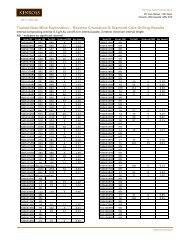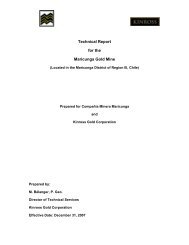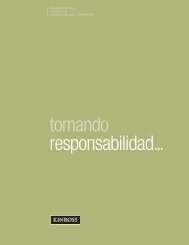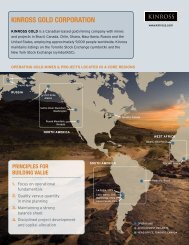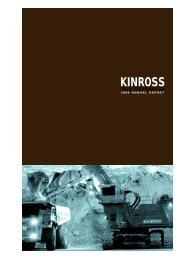Technical Report for the Fort Knox Mine - Kinross Gold
Technical Report for the Fort Knox Mine - Kinross Gold
Technical Report for the Fort Knox Mine - Kinross Gold
Create successful ePaper yourself
Turn your PDF publications into a flip-book with our unique Google optimized e-Paper software.
<strong>Fort</strong> <strong>Knox</strong> <strong>Mine</strong> <strong>Technical</strong> <strong>Report</strong>7.0 GEOLOGICAL SETTINGThe <strong>Fort</strong> <strong>Knox</strong> property is located in <strong>the</strong> Fairbanks mining district, a southwest–nor<strong>the</strong>asttrending belt of lode and placer gold deposits that comprise one of <strong>the</strong> largest goldproducing areas in <strong>the</strong> state of Alaska. The Fairbanks district is situated in <strong>the</strong>northwestern part of <strong>the</strong> Yukon–Tanana - Uplands. The Yukon – Tanana terraneconsists of a thick sequence of poly-metamorphic rocks that range from Precambrian toupper Paleozoic. The polymetamorphic protoliths were primarily sedimentary, volcanic,and volcanoclastic units, with only minor plutonic rocks. The region has undergone atleast two periods of dynamo - <strong>the</strong>rmal metamorphism, which included an early progradeamphibolite event, followed by a retrograde, greenschist facies event (Bundtzen, 1981).A more complex de<strong>for</strong>mational history identifying four phases of penetrative tectonismhas been suggested by Hall, 1985.The Fairbanks Schist, which is Proterozoic to lower Paleozoic, is <strong>the</strong> dominant lithologyin <strong>the</strong> district. It is composed of quartz-muscovite schist, muscovite-feldspar-quartzschist, micaceous quartzites, metaconglomerate, garnet - hornblende amphibolite, andmarble, indicative of an emergent shelf environment. The Cleary Sequence consistingof bimodal meta-rhyolite and meta-basalt with actinolite schist, chlorite schist, graphiteschist, and impure marbles is intercalated with <strong>the</strong> Fairbanks Schist, indicating immaturerift basins in <strong>the</strong> shelf environment. Geological work per<strong>for</strong>med in 1996 has led toreassigning <strong>the</strong> meta-rhyolite in <strong>the</strong> Cleary Sequence to <strong>the</strong> Devonian MuskoxSequence and placing it in fault contact with <strong>the</strong> Fairbanks Schist. In <strong>the</strong> nor<strong>the</strong>rn part of<strong>the</strong> district, metamorphosed rocks of <strong>the</strong> Chatanika terrane have been identified. Thesequence includes type C eclogites, impure marbles, amphibolites, calc-muscoviteschist, garnet-muscovite schist, and muscovite schist, containing garnet, biotite, chloriteand graphite. The Chatanika unit in fault contact with <strong>the</strong> Fairbanks Schist is thought tobe middle Paleozoic to Ordovician and may represent a telescoped, mature rift basinwithin <strong>the</strong> shelf environment. Amphibole from <strong>the</strong> Chatanika unit yielded an OrdovicianK-Ar date (Robinson, 1990). Figure 7-1 illustrates <strong>the</strong> location of <strong>the</strong> <strong>Kinross</strong> projectswithin this geologic setting.25



